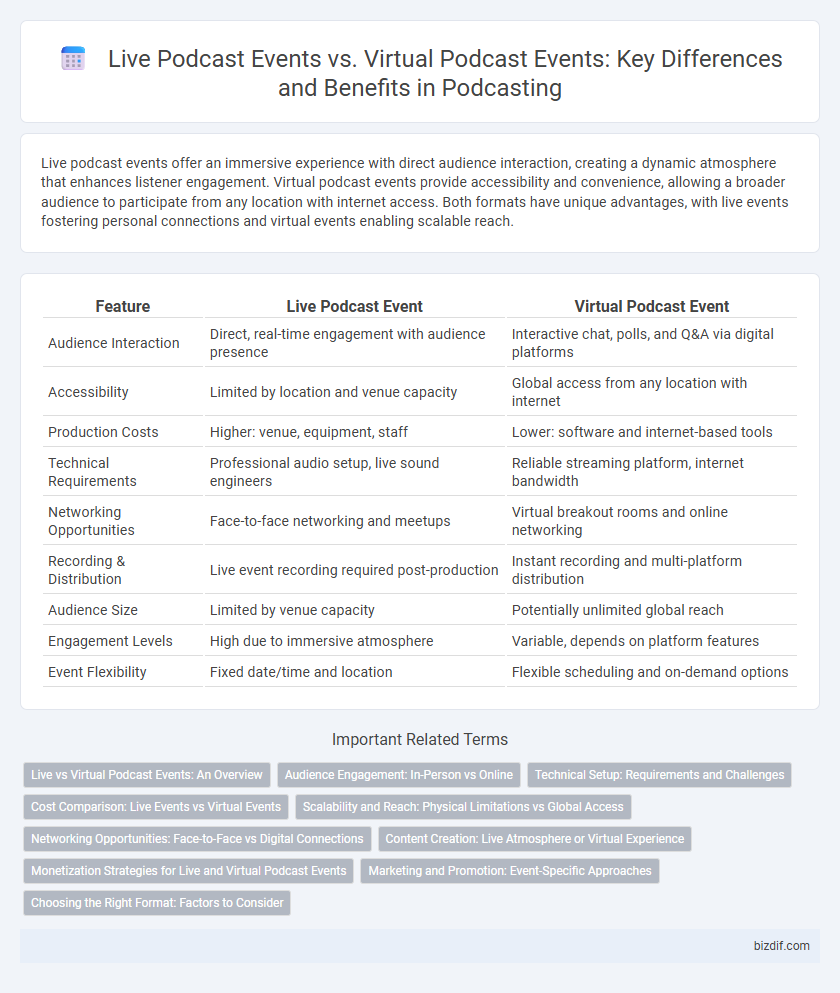Live podcast events offer an immersive experience with direct audience interaction, creating a dynamic atmosphere that enhances listener engagement. Virtual podcast events provide accessibility and convenience, allowing a broader audience to participate from any location with internet access. Both formats have unique advantages, with live events fostering personal connections and virtual events enabling scalable reach.
Table of Comparison
| Feature | Live Podcast Event | Virtual Podcast Event |
|---|---|---|
| Audience Interaction | Direct, real-time engagement with audience presence | Interactive chat, polls, and Q&A via digital platforms |
| Accessibility | Limited by location and venue capacity | Global access from any location with internet |
| Production Costs | Higher: venue, equipment, staff | Lower: software and internet-based tools |
| Technical Requirements | Professional audio setup, live sound engineers | Reliable streaming platform, internet bandwidth |
| Networking Opportunities | Face-to-face networking and meetups | Virtual breakout rooms and online networking |
| Recording & Distribution | Live event recording required post-production | Instant recording and multi-platform distribution |
| Audience Size | Limited by venue capacity | Potentially unlimited global reach |
| Engagement Levels | High due to immersive atmosphere | Variable, depends on platform features |
| Event Flexibility | Fixed date/time and location | Flexible scheduling and on-demand options |
Live vs Virtual Podcast Events: An Overview
Live podcast events create immersive, real-time interactions between hosts and audiences, enhancing engagement through audience reactions and spontaneous dialogue. Virtual podcast events leverage digital platforms to reach a global audience, offering convenience and accessibility without geographical constraints. Both formats present unique opportunities for content delivery, audience participation, and monetization strategies within the podcasting industry.
Audience Engagement: In-Person vs Online
Live podcast events foster deeper audience engagement through real-time interactions, spontaneous Q&A sessions, and the immersive atmosphere of shared physical presence. Virtual podcast events offer interactive features like live chat, polls, and instant feedback, enhancing accessibility and enabling participation from a global audience. Both formats leverage unique engagement tools that cater to different audience preferences and expand podcast reach.
Technical Setup: Requirements and Challenges
Live podcast events demand robust audio equipment, high-quality microphones, and reliable sound mixers to ensure clear sound capture amid dynamic audience interactions, with challenges including managing ambient noise and real-time technical glitches. Virtual podcast events require stable internet connections, advanced streaming software, and integrated platforms to facilitate seamless communication between hosts and remote guests, facing challenges like latency, bandwidth limitations, and synchronization issues. Both formats need backup systems and expert technical support to minimize disruptions and maintain broadcast quality.
Cost Comparison: Live Events vs Virtual Events
Live podcast events typically incur higher costs due to venue rental, on-site equipment, staffing, and attendee accommodations, which can range from a few thousand to tens of thousands of dollars depending on scale and location. Virtual podcast events significantly reduce expenses by eliminating physical venue fees and travel costs, relying primarily on digital platforms and streaming technology with subscription or service fees often under a few hundred dollars. Budget-conscious podcasters can maximize reach and minimize costs by leveraging virtual event platforms, while live events may offer enhanced audience engagement despite the higher financial investment.
Scalability and Reach: Physical Limitations vs Global Access
Live podcast events face physical limitations such as venue capacity, geographic constraints, and logistical challenges, restricting audience size and scalability. Virtual podcast events enable global access through online streaming platforms, allowing unlimited attendance from diverse locations. This digital format significantly enhances reach and scalability, making it ideal for expanding podcast audiences worldwide.
Networking Opportunities: Face-to-Face vs Digital Connections
Live podcast events foster dynamic networking opportunities through face-to-face interactions, enabling attendees to build deeper, more personal connections and engage spontaneously with hosts and fellow listeners. Virtual podcast events offer broad accessibility and convenience, allowing participants to connect digitally across geographic boundaries via chat rooms, Q&A sessions, and social media integration. While live events create immersive, tangible networking experiences, virtual events facilitate scalable, inclusive community building with a focus on sustained online engagement.
Content Creation: Live Atmosphere or Virtual Experience
Live podcast events capture authentic audience energy, spontaneous interactions, and real-time feedback that enhance content vibrancy and engagement. Virtual podcast events leverage interactive tools, global accessibility, and multimedia integration to create dynamic, customizable experiences for diverse audiences. Both formats influence content creation by shaping delivery style, audience participation, and post-production editing strategies.
Monetization Strategies for Live and Virtual Podcast Events
Live podcast events generate revenue through ticket sales, merchandise, and exclusive in-person experiences that drive higher audience engagement and sponsorship value. Virtual podcast events monetize via digital ticketing, pay-per-view access, and integrating affiliate marketing or branded content to reach a global audience efficiently. Combining both formats with hybrid monetization strategies maximizes income streams by leveraging physical attendance perks and scalable online distribution.
Marketing and Promotion: Event-Specific Approaches
Live podcast events generate excitement through in-person engagement, leveraging local advertising, venue partnerships, and exclusive merchandise to create buzz and deepen audience connection. Virtual podcast events utilize digital marketing strategies including social media campaigns, email promotions, and targeted online ads to reach a global audience efficiently. Both approaches benefit from tailored content teasers and interactive elements designed to maximize audience participation and boost overall visibility.
Choosing the Right Format: Factors to Consider
Choosing the right podcast event format depends on audience engagement, technical capabilities, and budget constraints. Live podcast events offer real-time interaction, fostering community and immediate feedback, while virtual events provide broader accessibility and flexible participation. Consider factors like location, audience size, and desired interactivity to maximize reach and impact.
Live podcast event vs Virtual podcast event Infographic

 bizdif.com
bizdif.com